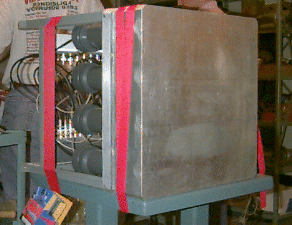Characterization of LANSA Elements
Jason Law, Brian Fisher, Brian DeMarco
Faculty Advisor: Dr. Steve Padalino
LLNL Collaborators – Mike Cable and Mike Nelson
MEDUSA is the large neutron scintillator array used at the University of Rochester’s Lawrence Livermore National Lab (LLNL). At Geneseo, we are attempting to determine the efficiency and energy response of two parts of the array.

A bit of LANSA
Jason Law explains his research to Bob Runkle
Here is the abstract for the poster that Jason Law will be giving at the March 1996 APS meeting:
Neutron calibration experiments of two 16 element sections of the Large Area Neutron Detector Array (LANSA) are underway at Geneseo’s Nuclear Structure Laboratory. LANSA, which is being used at Lawrence Livermore National Laboratory to study laser driven fusion reactions, is a detector array composed of 960 neutron detectors. Two small sections of the array have been removed and sent to the State University of New York at Geneseo to be calibrated with d-d and d-t neutrons. The neutrons are produced via the d(d,n)3He and t(d,n)4He nuclear reactions using Geneseo’s Van de Graaf accelerator. The neutrons are produced at lab energies of approximately 3 and 14 MeV, respectively, and are used with coincident Helium nuclei to calibrate the detector array elements individually. Gamma ray studies of these detectors were also undertaken during the summer of 1995 to determine their base line response and gain matching.
